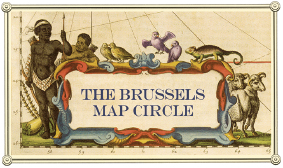New collaboration between Rumsey Map Collection and Machines Reading Maps
Machines Reading Maps (MRM) is delighted to announce a new 1-year collaboration with the David Rumsey Map Collection. Thanks to a generous donation from David Rumsey himself, the MRM teams (including researchers at The Alan Turing Institute, the University of Minnesota, and the Austrian Institute of Technology) will be able to test and expand its tools and methods working large and diverse collection of 60 000 digitised historical maps.
This research will make the Rumsey Map Collection the first large digitised map collection in the world to be fully searchable via text. For all the place names, we will also infer the semantic types and the links to external knowledge bases like Wikidata. This will make countless features that did not previously appear in the map’s metadata, finally visible and discoverable. At the same time, the enrichment of the maps will enable, for the first time, complex searches across different map series, like finding saloons in nineteenth-century California or all the businesses found within two miles of British railway stations.
Building on top of the ongoing work on collections held at the National Library of Scotland, British Library and Library of Congress, and supported by AHRC and NEH funding, this new collaboration will enable MRM to process a large corpus of georeferenced maps (around 60 000 documents) in the David Rumsey collection with the computer-vision-based machine learning model mapKurator. mapKurator detects and recognises the text on maps, in a wide variety of scripts and styles, and then links those labels (including only partially recognised ones) to external knowledge bases like OpenStreetMap or WikiData.
The first outcomes will be fine tuned through two processes: one computational and one manual. The first one involves the training of artificial intelligence models using real maps from the Rumsey collection and synthetic ones developed by the project team. For the second, the project will extend LUNA, the Rumsey Collection's online map viewer, with annotation functionality. Building on a bespoke annotation system developed in MRM, the new annotation interface will make it possible for the public to help validate and improve the annotations produced automatically via mapKurator.
This collaboration with the Rumsey Collection will sharpen MRM tools, making them more flexible in new contexts. In particular, it allows the researchers to explore solutions for dealing with the challenging scale and variety of this unique collection, which features dozens of different languages and cartographic traditions. The MRM and David Rumsey Map Collection teams also look forward to collaborating with a large and diverse community of users, and to making them co-authors of the maps' enrichment.
This operation will generate an unprecedented amount of free and reusable data, of great historical, geographical, scientific, and anthropological value, as well as precious metadata that will improve the accessibility of the collection, and active engagement with map enthusiasts.
At the end of this collaboration, we will showcase the data and the new functionalities implemented, and discuss next steps in a public event hosted at the David Rumsey Map Center at Stanford Libraries. Source: David Rumsey Map Collection
Posted on
